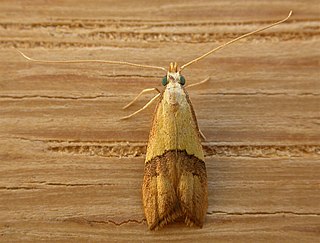
Crocanthes prasinopis is a species of moth of the family Lecithoceridae. It is found in most Australia and New Guinea.

Scoparia pyralella, the meadow grey, is a species of moth of the family Crambidae. It was first described by Michael Denis and Ignaz Schiffermüller in 1775.
Brachmia carphodes is a moth in the family Gelechiidae. It was described by Edward Meyrick in 1908. It is found in Assam, India.
Leuronoma textifera is a moth of the family Gelechiidae. It was described by Edward Meyrick in 1913. It is found in South Africa.
Ephysteris semiophanes is a moth in the family Gelechiidae. It was described by Edward Meyrick in 1918. It is found in Sri Lanka.

Lysipatha diaxantha is a moth in the family Gelechiidae. It was described by Edward Meyrick in 1932. It is found in Taiwan.
Mnesistega talantodes is a moth in the family Gelechiidae. It was described by Edward Meyrick in 1918. It is found in southern India.
Anacampsis multinotata is a moth of the family Gelechiidae. It was described by Edward Meyrick in 1918. It is found in Guyana.
Ornativalva caecigena is a moth of the family Gelechiidae. It was described by Edward Meyrick in 1918. It is found in Saudi Arabia, Kuwait, southern Iran (Luristan) and Pakistan.
Antaeotricha sparganota is a moth of the family Depressariidae first described by Edward Meyrick in 1915. It is found in Guyana.
Carodista melicrata is a moth in the family Lecithoceridae. It was described by Edward Meyrick in 1910. It is found in Assam, India.
Dragmatucha proaula is a moth in the family Lecithoceridae. It was described by Edward Meyrick in 1908. It is found in Botswana, Mozambique, Namibia, South Africa (Limpopo) and Zimbabwe.
Lecithocera xanthophaea is a moth in the family Lecithoceridae. It was described by Edward Meyrick in 1926. It is found on Borneo.
Phatnotis factiosa is a moth in the family Lecithoceridae. It was described by Edward Meyrick in 1913. It is found in southern India.
Epichostis antigama is a moth in the family Xyloryctidae. It was described by Edward Meyrick in 1908. It is found in southern India.
Aeolanthes ampelurga is a moth in the family Depressariidae. It was described by Edward Meyrick in 1925. It is found in northern India (Kumaon).
Comotechna scutulata is a moth in the family Depressariidae. It was described by Edward Meyrick in 1921. It is found in Brazil.
Gonionota comastis is a moth in the family Depressariidae. It was described by Edward Meyrick in 1909. It is found in Peru and Colombia.
Imma amphixantha is a moth in the family Immidae. It was described by Edward Meyrick in 1906. It is found on Borneo.

Tingena eumenopa is a species of moth in the family Oecophoridae. It is endemic to New Zealand and found in the North and South Islands. The adults have been found amongst tree ferns and are on the wing in December.



